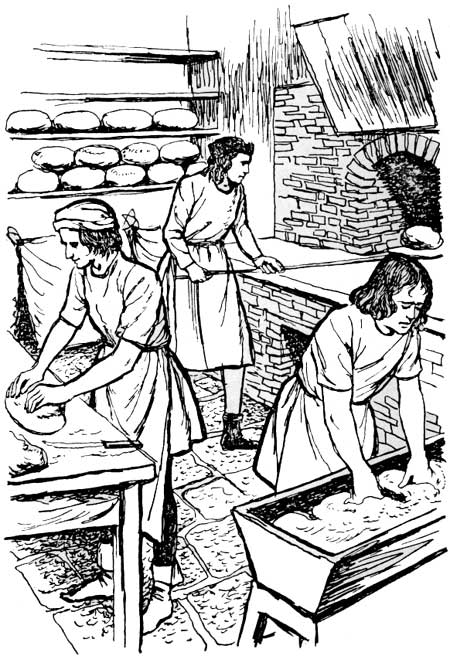The History of Bread
page 2
The Romans enjoyed several kinds of bread,
...with interesting names. There was oyster bread (to be eaten with oysters); 'artolaganus' or cakebread; 'speusticus' or 'hurry bread'. There was oven bread, tin bread, and Parthian bread. There were rich breads made with milk, eggs and butter, but these of course, were only for the wealthy and privileged people. The Egyptiangrammarian and philosopher Athenaeus, who lived in the third century AD, has handed down to us considerable
knowledge about bread and baking in those days.
He wrote that the best bakers were from Phoenicia or Lydia, and the
best bread-makers from Cappadocia. He gives us a list of the sorts of
bread common in his time-leavened and unleavened loaves; loaves made from the best wheat flour; loaves made from groats, or rye, and some
from acorns and millet. There were lovely crusty loaves too, and
loaves baked on a hearth. Bakers made bread mixed with cheese, but
the favorite of the rich was always white bread made from wheat. In
ancient Greece, keen rivalry existed between cities as to which
produced the best bread
|
Athens claimed the laurel wreath, and the name of its greatest baker, Thearion, has been handed down through the ages in the writings ofvarious authors. During the friendly rivalry between the towns, Lynceus sings the praises of Rhodian rolls. "The Athenians", he says, "talk a great deal about their bread, which canbe got in the market, but the Rhodians put loaves on the table which are not inferior to all of them. When our guests are given over to eating and are satisfied, a most agreeable dish is produced called the "hearth loaf", which is made of sweet things and compounded so as to be very soft, and it is made up with such an admirable harmony of all the ingredients as to have a most excellent effect, so that often a man who is drunk becomes sober again, and in the same way, a man who has just eaten is made hungry by eating of it."
The island of Cyprus had a reputation for good bread. Another old
writer, Eubulus, says, "Tis a hard thing, beholding Cyprian loaves,
to ride carelessly by, for like a magnet, they do attract the hungry
passengers." All through the ancient days, bread and bakers were held
in the highest respect; this respect lives on to our times, for what
would we do without our bakers?
|
In early English historical times, there were constantly recurring
periods of famine, due to not enough, or too much rain, or frosts,
and other natural causes. The ruling classes, knowing that rebellion
often followed famine, did their utmost to keep the price of bread
from rising too high. Laws regulating its price were passed during
the reign of King John (1202). Not only did the law fix the price,
but also it strictly allocated that price between cost of material
and an allowance for necessary charges to the baker. In 1266, the law
allowed the baker twelve pence for each quarter of wheat he made into
bread, split as follows:
For three servants,4½d. *The reason for this ½d. for sieving
was, that in those days, the baker - not the miller as now -
separated out the wheat flour into its white and brown categories.
This does not add up to twelve pence - apparently the baker was
allowed a quantity of bread and bran to make up the difference. The
amounts seem tiny, but this is due to the greater value of money in
those days.
For two boys 1d.
For salt ½d.
For yeast ½d.
For candles ¼d.
For wood 2d.
For sieving ½d.
 12d (old pennies), or one shilling is worth 5p
|
 |
Picture of a medieval English Bakery
From Fort Vancouver Bakery by
by
John A. Hussey
|
|
|
For instance, a master carpenter would be paid only 2d. per day,
ordinary woodworkers were receiving only 1½d. Bakers earned less than
this, but they were not dependent on the weather and could always be
at work, unlike the carpenters. All through English history, great
efforts were made to keep the price of bread low, to maintain good
quality, and to prevent corruption and dishonesty.
The bakers liked to keep the 'mystery' of the trade to themselves
and to prevent unlicensed people from starting up. If a young man
wanted to become a baker, he had to serve an apprenticeship of seven
years. The law supported the bakers in preserving their craft to
themselves, and there were statutes published with various penalties
for infringement. In those days there were certain dishonest persons
in the trade. We read that in 1298 AD heavy fines were inflicted on
bakers for selling short weight bread. There are the most stringent
regulations about the weight of bread today. No baker would wittingly
sell underweight. Bakers are sometimes, it is true, prosecuted for so
doing but this is invariably due to faulty machinery or sometimes
lack of proper supervision. The fines are pretty stiff.
|
Page 1 Page 3 Page 4
Links
Freshloaf an Old Fashioned Bakery
The Story behind a loaf of Bread
|
|
|


